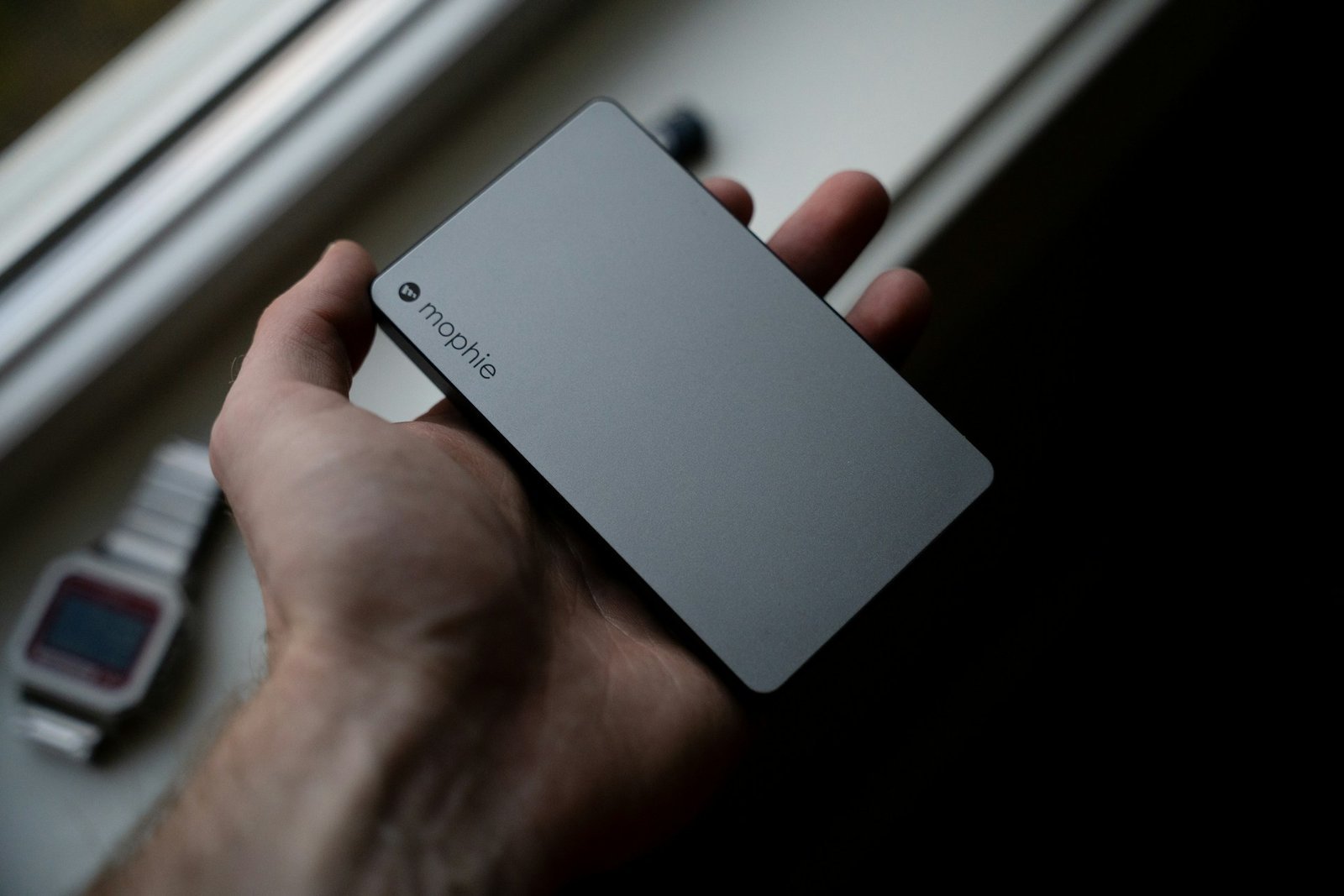Introduction to Portable Chargers
In today’s fast-paced, gadget-driven world, the demand for portable chargers has grown exponentially. Many individuals rely extensively on their smartphones, tablets, and laptops for both personal and professional purposes. As a result, these devices frequently require charging throughout the day. However, one common dilemma encountered by users is the untimely exhaustion of battery life, which can occur at the most inconvenient moments, such as during a critical phone call, an important presentation, or while traveling. This is where portable chargers come into play, providing a convenient solution to keep devices powered up and functional.
Portable chargers, often referred to as power banks, serve the primary purpose of offering an external power source for various electronic devices. They come in a variety of sizes, capacities, and features, empowering users to select the one that uniquely aligns with their charging needs. Regardless of whether it is a long day out in the city or a camping trip in the wilderness, having a portable charger can alleviate the stress of low battery anxiety. This technology is not just a luxury; it has become an essential accessory for those who are constantly on the move.
The intention of this blog post is to provide a comprehensive guide to portable chargers, exploring the various factors that one should consider when choosing the most suitable option. This discussion will cover aspects such as battery capacity, charging speed, portability, and additional features that could enhance the user experience. By delving into these crucial elements, readers will gain valuable insights that will assist them in making an informed decision tailored to their specific needs. With portable chargers becoming indispensable gadgets, equipping oneself with the right knowledge is paramount.
What is a Portable Charger?
A portable charger, often referred to as a power bank or battery pack, is a compact device designed to store electrical energy and provide a convenient way to recharge mobile electronic devices when access to a traditional power outlet is unavailable. In an increasingly mobile world, portable chargers have become essential accessories, particularly for busy professionals, travelers, and anyone who relies on devices such as smartphones, tablets, or portable gaming systems. These devices function by converting stored electrical energy into a form that can recharge the batteries of compatible gadgets.
There are several types of portable chargers available on the market today. Power banks are the most common type, consisting of a battery encapsulated in a durable casing. They come in various capacities, typically measured in milliampere-hours (mAh), which indicates how much charge they can hold and the number of times they can recharge devices before needing a recharge themselves. For example, a power bank with a capacity of 10,000 mAh could potentially charge a smartphone with a 2,500 mAh battery four times over.
Another category is solar-powered chargers, which harness energy from sunlight to charge devices. These are especially beneficial for outdoor enthusiasts and travelers, as they provide a renewable source of energy. Moreover, some portable chargers feature built-in technology that allows for faster charging or come with multiple output ports to charge multiple devices at once.
Overall, portable chargers play a critical role in our day-to-day lives, serving the primary function of maintaining device usability and functionality on-the-go. Understanding the various types and how they work equips users to select the right portable charger that aligns with their specific charging needs and device compatibility.
Why You Need a Portable Charger
In today’s fast-paced digital world, staying connected is essential for both personal and professional life. The reliance on smartphones, tablets, and other portable devices has surged, creating a substantial need for reliable power sources. A portable charger, also known as a power bank, has become a crucial accessory for individuals who must maintain connectivity while on the go. This necessity is particularly evident in various scenarios such as travel, work, and everyday mobile usage.
When traveling, whether for leisure or business, having a portable charger can significantly alleviate the stress associated with low battery levels. Travelers often find themselves exploring new cities or attending back-to-back meetings without access to charging outlets. A portable charger provides the freedom to explore without the apprehension of losing power on essential devices. Additionally, extended travel times, especially on flights or long road journeys, can drain devices quickly, making it imperative to have a reliable power source at hand.
In the workplace, professionals increasingly rely on mobile devices to stay productive. Meetings, presentations, and client calls often require usage of smartphones and tablets, which can lead to rapid battery depletion. With a portable charger, employees can ensure their devices remain operational throughout the day, enhancing their overall productivity and providing peace of mind during important tasks.
Furthermore, during daily life, whether commuting, exercising, or socializing, individuals frequently find themselves in need of charging options. A portable charger offers flexibility; it can easily fit into a bag or pocket, allowing easy access whenever necessary. With the growing dependence on technology, the availability of a portable charger becomes indispensable in fulfilling daily charging demands.
Key Features to Consider When Choosing a Portable Charger
When selecting a portable charger, several key features must be taken into account to ensure it meets your needs effectively. One of the foremost specifications to evaluate is the capacity of the charger, typically measured in milliamp hours (mAh). A higher mAh rating generally translates to a greater ability to charge your devices multiple times. For instance, a 10,000mAh portable charger can typically recharge a smartphone two to three times, whereas a 20,000mAh unit may offer even more life. It is essential to select a capacity that aligns with your usage habits and device battery requirements.
Equally important is the size and weight of the portable charger. If portability is a priority for you, finding a compact and lightweight option can be advantageous, allowing for ease of transport without adding significant bulk to your bag. In the context of energy consumption, a balance must be struck between capacity and portability; heavier chargers often hold more energy but can be cumbersome to carry.
Another critical consideration is charging speed, which is indicated by the output rating, usually measured in amperes (A). A charger with higher output ratings can charge devices more quickly, making it particularly essential for users who require rapid charging capabilities to minimize downtime. Moreover, the number of ports available on a portable charger can also affect its usability. Having multiple ports enables simultaneous charging of several devices, which can be beneficial for multi-device users.
Compatibility with various devices shouldn’t be overlooked either. Ensure that the chosen portable charger can effectively support your smartphones, tablets, and other electronic devices. Lastly, do not neglect safety features such as overcharge protection, short circuit prevention, and temperature control, as they provide an additional layer of security for both the charger and your devices.
The Best Portable Chargers on Amazon: A Comparison Table
When it comes to selecting a portable charger, Amazon offers a diverse array of options that cater to various needs and budgets. After thorough research, we have curated a list of some of the best portable chargers you can find on the platform.
First on our list is the Aukey 20000mAh Portable Charger. With its high capacity, this power bank can recharge your smartphone multiple times before needing a recharge itself. It features dual USB outputs, allowing users to charge two devices simultaneously, making it an excellent choice for travelers who need to keep multiple devices powered up. Furthermore, its compact design means it can easily fit in a bag without taking up too much space.
Next, we have the Anker PowerCore Slim 10000 mAh charger. Known for its lightweight and slim design, this portable charger is perfect for daily use. Its PowerIQ technology optimally adjusts the output for efficient charging. The Anker brand is well-regarded for its reliability, and this model stands out for its blend of portability and performance, making it suitable for those who are always on the go.
For those seeking an eco-friendly option, the <strong{ravpower 16750mah=”” bank is a commendable choice. It harnesses solar energy, providing a sustainable way to keep your devices charged during outdoor activities. With its rugged design and built-in flashlight, it is particularly suitable for hikers and campers who may have limited access to traditional power sources.
Lastly, the Zendure A2 Portable Charger offers durability and high-speed charging capabilities. With its unique crush-proof design, this charger excels in protecting itself against drops and impacts, making it ideal for those who lead an active lifestyle. It also features two USB ports, ensuring that users can effortlessly maintain the battery life of all their gadgets.
Each of these portable chargers showcases a specific feature set tailored to different user preferences. By evaluating your personal needs and choosing a charger that aligns with them, you can ensure a seamless charging experience wherever you may be.
Safety Tips when Using Portable Chargers
With the increasing reliance on portable chargers for maintaining device functionality, it is essential to prioritize safety when using these devices. To safely charge your devices, start by selecting a portable charger that complies with established safety standards. Look for certifications such as UL, CE, or FCC, which indicate that the charger has passed rigorous safety testing. High-quality chargers are designed with built-in protections against overcharging, short circuits, and overheating, ensuring the safety of both the user and the device.
It is crucial to avoid common pitfalls associated with portable chargers. One of the most prevalent issues is using a charger that is not compatible with your device. Always check the voltage and amperage specifications to ensure that the charger meets your device’s requirements. Using an incorrect charger can lead to inefficiencies or even damage to your device’s battery. Furthermore, avoid exposing portable chargers to extreme temperatures, as excessive heat or cold can compromise their performance and safety.
In addition to choosing a certified charger, opt for high-quality cables, as the performance of your portable charger is often tethered to the cables used. Poor-quality cables can lead to significant complications, including slower charging speeds and increased wear on device ports. To maximize safety, ensure that you regularly inspect both your portable charger and its cables for any signs of wear, such as frays, cracks, or other indicators of potential failure.
Lastly, remember to avoid charging devices overnight or for extended periods without supervision. While many modern chargers have safety features, leaving them unattended increases the risk of malfunction. By adhering to these safety tips, users can effectively protect their devices and enhance the overall charging experience while utilizing portable chargers.
Comparing Different Types of Portable Chargers
In the world of portable chargers, various types cater to distinct needs and preferences, making it essential to evaluate their functionalities. Among the most prevalent types are solar chargers, wireless chargers, and ultra-fast charging models. Each of these options bring unique advantages and potential drawbacks, which are crucial for users to consider.
Solar chargers harness sunlight to generate power, making them an environmentally friendly option. They are particularly beneficial for outdoor enthusiasts and travelers who may find themselves away from traditional power sources for extended periods. However, their efficiency can be limited by weather conditions, and they often require longer charging times compared to other types.
Wireless chargers offer the convenience of cable-free power delivery. With the rise of Qi technology, various devices can now be powered simply by placing them on the pad. This design simplifies the charging process, making it a suitable option for everyday use. Nonetheless, wireless chargers typically have slower charging speeds and may generate heat, which can affect battery health over time.
Ultra-fast charging models are designed for users who require quick power boosts. These chargers can significantly reduce the time needed to charge devices, allowing for busy individuals to regain power in a matter of minutes. However, they often come at a higher price point and may not be compatible with every device, which can be a limitation for some users.
When selecting a portable charger, it is essential to consider the specific features that align with your lifestyle. Whether you prioritize environmental sustainability, ease of use, or rapid recharging capabilities, understanding the pros and cons of each type can help you make an informed decision tailored to your requirements.
Maintaining Your Portable Charger
To ensure the longevity and efficiency of your portable charger, proper maintenance is crucial. A portable charger, also known as a power bank, is an indispensable tool in our increasingly mobile world, making it essential to follow best practices in its care. One of the primary aspects of maintenance is how the device is charged. It is advisable to avoid letting the battery fully deplete before recharging. Instead, aim to recharge your power bank when its battery level drops to around 20%. This habit helps in preserving the charge cycles and overall health of the battery.
Equally important is the method used for charging your portable charger. Utilizing a quality charging cable that meets the manufacturer’s specifications ensures safe and effective power transfer. Avoid using cables or adapters from unknown sources, as they could potentially damage your device. Additionally, charging the power bank on a stable surface and avoiding extreme temperatures are vital, as high heat can lead to battery degradation. Keeping the power bank in a cool, dry place will contribute to its optimal performance.
Storage practices also play an essential role in maintaining your portable charger. If the charger is not in use for an extended period, it is recommended to store it at a state of approximately 50% charge. This balances the charge level, preventing over-discharge, which could lead to battery failure. Regularly checking the charge level and recharging as necessary will help in avoiding issues related to inactivity.
Lastly, it is advisable to keep the ports of your power bank clean and free from dust and debris. Gently wiping the connectors with a dry, lint-free cloth can prevent connectivity issues and ensure efficient power transfer during use. By implementing these maintenance tips, you can extend the life of your portable charger and ensure that it continues to meet your charging needs effectively.
Conclusion: Finding the Right Portable Charger for You
In today’s digital age, portable chargers have become an essential accessory for many individuals. Their ability to provide convenience and ensure that devices remain charged while on the move cannot be understated. As smartphones, tablets, and other electronic devices increasingly rely on battery power, understanding the various features and options available in portable chargers becomes crucial for making an informed purchasing decision.
When assessing the right portable charger for your needs, consider factors such as capacity, charging speed, and size. A higher capacity ensures that your device can remain powered throughout the day, especially if you often find yourself away from traditional power sources. Moreover, with advancements in charging technology, faster charging options can significantly reduce wait times, allowing for a more seamless experience. Size and weight also play vital roles, particularly for those who prioritize portability and convenience when traveling or commuting.
Furthermore, evaluating additional features—such as multiple outputs, compatibility with various devices, and built-in safeguards against overcharging—can enhance the overall performance of a portable charger. These considerations can lead to a better experience, ultimately ensuring that you can stay connected without interruption.
Before making a purchase, reflect on your lifestyle and charging habits, and determine which features align with your requirements. The vast array of options available on platforms such as Amazon provides opportunities to find a portable charger suited to your specific needs. By taking the time to research and evaluate your choices, you can confidently select a product that not only meets but exceeds your expectations.




